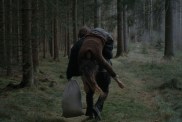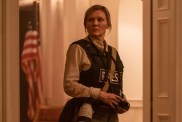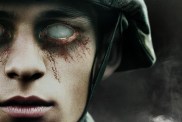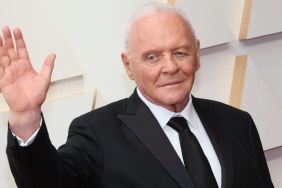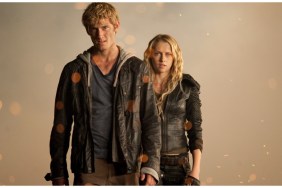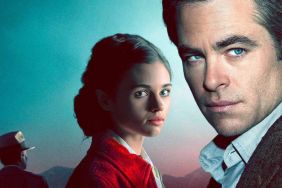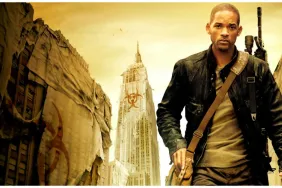Visiting the DreamWorks editing suites is something of an adventure in and of itself. Tucked away within the Universal lot in Hollywood is a series of near-bungalows, surrounded by palm trees and other greenery. A number of large wooden doors and security checkpoints give off an impression less that one has arrived on a studio lot and more a tropical hotel. A flash of being at Jurassic Park, too, isn’t entirely out of the question, even before entering the long hallway of the main building, finding an incredible stretch of wall lined with posters to Steven Spielberg’s films.
In this, D.J. Caruso finds himself in good company as he puts the finishing touches on I Am Number Four, his upcoming adaptation of the book of the same name, written by Pittacus Lore.
“He came in Friday,” smiles Caruso when asked how involved Spielberg has been as a producer on the project, “He’s right across the way, so anytime we want to show him something like a visual effect, he comes in. Usually he wants to listen to music. Usually when we’re stuck on two versions of something and aren’t sure, we’ll try to get his opinion.”
Cuing the AVID to the very start of the film, Caruso introduces us to the rules of his science fiction world. Though the backdrop is more or less our own, present reality, I Am Number Four deals with the final nine survivors of the planet Lorien and their plight to survive on Earth, hidden as members of human society from a violent race called the Mogadorians who would see them hunted to extinction.
We open on a shot of the Earth as seen from space. Zooming in, the planet is turning and we keep going, through the atmosphere and down to the jungle in one continuous take. By the time we’ve reached the ground, it’s no longer a zoom, but a tracking shot, moving across the dense rainforest to a sort of tribal hut, built out of bamboo. Inside, a young man sleeps beneath a mosquito net and, just across the room, an older man follows suite.
There’s a noise from the front door and the bamboo latch clicks as though someone is trying to pick a lock. In seconds, both are awake and the older man reaches for a sword, the hilt of which glows blue when it makes contact with his palm. He looks to the door, nervous, but all is silent.
Suddenly, a crash destroys the moment of relief as something breaks through the entire wall, overtaking the older man. The younger kid doesn’t miss a beat. He’s up and somersaults out the window, leaping and diving with incredible agility through the foliage. Something’s after him an tremendous four-limbed creature whose sheer force tears apart the overgrowth the youth skillfully dodges.

The kid makes it to a ledge and dives, throwing himself into the darkness, but he’s not fast enough. His pursuers have overtaken him. First one, seven-foot being, bald and dressed in black with an unearthly face and tattoo-like markings. More join on either side, whispering in a language we can’t understand.
Grabbing the boy’s neck, the creature pulls free a silver medallion from his body, just as the hunter stabs at his prey, causing the child to explode in a cloud of particles. We move in on the medallion and the scene goes out, matching the alien design of the metal with the film’s logo.
Fans of the book will instantly know that we’ve seen the death of Number Three, third of the nine survivors of Lorien. Thanks to a protection charm put upon the nine, the Mogadorians can only kill in the assigned numerical order.
Though Three’s story is only hinted at in both the book and the film, Caruso plays up the parallel to Alex Pettyfer’s character, Number Four. Both live with their older guardian, charged with the youth’s protection. Greg Townley, a 14-year-old world champion gymnast plays the part of Three, incredibly supplying the acrobatics without any addition effects.
From the opening title, we jump to the life of Number Four and his own guardian, Henri (Timothy Olyphant). Currently hiding out in Florida, Four is seen riding on jetskis with friends, making a life for himself and, after some waterski hotdogging, getting the attention of an attractive girl on the beach.
Night falls and Four and the girl head into the water, swimming together in the darkness. Just as he’s about to make a connection, though, something goes wrong. He falls beneath the surface as images of Three’s death flash before his eyes. Along his leg is a series of patterns, sort of like a mix between tattoos and brands. One of them is lighting up and, even as he struggles to the surface, has him in intense pain.
“Number Three is dead,” he tells Henri the next morning. The guardian is obviously not happy with the news and begins to pack, swapping the license plates on his car for another state and offering Four his new identity. For now, he’ll be John Smith in a small town in Ohio, Paradise.
“I told you not to keep these things,” Henri tells John sternly, throwing photos of friends and personal mementos into a bonfire of their Florida life, “They just slow you down.”
“I think you always want to find someone in a dark period of their life,” explains Caruso on his attraction to troubled youths, something that has been prevalent in most of his films, “Ultimately, by the end of the movie, [you] hope that they see the light. From ‘The Salton Sea’ on, as dark as that movie was, there’s a little bit of hope at the end. In order to experience all the great things that life has to offer, you have to experience some bad things.”

With John and Henri having moved on, we jump to a scene introducing Six, played by Teresa Palmer. Without a guardian herself, she’s given up on hiding out and has decided to take the fight to the Mogadorians. First glimpsed at the remains of the Florida house, Six obliterates the rest of the evidence, enveloping the house in a fiery explosion that, just as it threatens to consume her, activates her other-worldly force field, a blue energy that protects her from the flame.
“If someone hadn’t read the book, they might ask, ‘Who is this?'” Caruso says of Six’s introduction in the beginning of the film, teased significantly earlier than she is in the novel, “But if they look closely, she has the same necklace. She has the same tattoos and little markings that Number Four has.”
Though Palmer is certainly a rapidly-rising talent and Olyphant has appeared across the board in film and television, part of the attraction for Caruso in casting was getting to deal with primarily fresh young faces.
“[We] didn’t have to have a movie star to get the movie going,” he says, “Conceptually, this was a good concept. Finding the right people for the roles was very liberating, because your movie isn’t contingent on ‘if we don’t get Brad Pitt, we don’t get the movie made’.”
Relative newcomer Pettyfer stars in the part of Four/John with “Glee’s” Dianna Agron stepping in to her first big-screen role as Sarah, John’s love interest.
Jumping to a later scene, Caruso showed off the relationship that begins to form between Sarah and John. Eating dinner at her house and meeting her parents, Sarah takes Four upstairs, showing him albums from her secret photography hobby. One camera is a favorite of her for its light-leaks and the interesting but unexpected photos it turns out. She offers it to John, saying, “Your turn.”
Outside of being an element of Sarah’s character, the behind-the-scenes photography of I Am Number Four is something special. Composed on 35mm in Super 1.85, Caruso and his cinematographer (Academy Award Winner Guillermo Navarro) have a taller frame at their disposal than the traditional release, something that Caruso is looking forward to playing with as part of the film’s planned IMAX release.

“Our Mogadorians are seven foot four inches tall,” he says. “It allows you to have just a little more top on the frame, so you don’t have to compromise and be tipping up more frames. You can shoot over Teresa Palmer, who happens to be 5’3 or 5’4 and still shoot Kevin Durand as a Mogadorians at 7’4′ without having to overcompensate for the frame.”
Rounding out the footage, Caruso showcased a variety of action shots from later in the film, including an all-out attack on Four at his high school where he, Six, Sarah and other new friends do battle with Mogadorians warriors and their gigantic beasts.
In the same way that Spielberg is able to step in and help with story advice, Caruso turns to producer Michael Bay for thoughts on cutting special effects. Though he jokes that his act six is where one of Bay’s films begins, having ILM available for special effects has been a tremendous boon to the project.
“A lot of time, my frustration with visual effects is that they’re like contractors who just redid your kitchen,” Caruso laughs, “You go in there and look at your kitchen and it’s crooked, right? You say, ‘Something f–ed up here. It’s crooked.’ And they’re like, ‘No, come stand over here.'”
Though Caruso’s aim with I Am Number Four is first and foremost to get the single film done and done well, the novel is planned as a series and Caruso promises a few subtle teases throughout, should subsequent novels go up for adaptation as well.
I Am Number Four, which launched its new trailer today (viewable here), is set to hit both regular and IMAX theaters on February 18, 2011.
